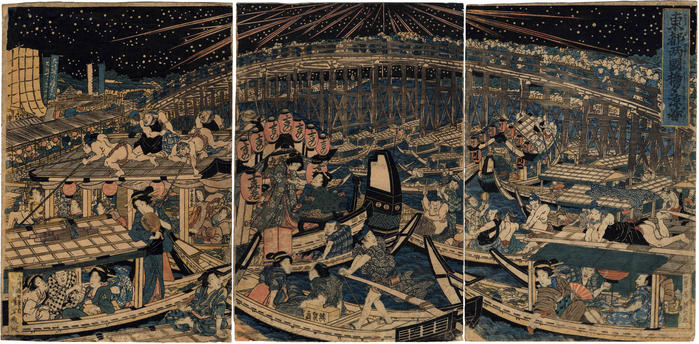Keisai Eisen (渓斎英泉) (artist 1790 – 1848)
A cool evening watching fireworks at Ryōgoku Bridge, Edo (Toto Ryōgokubashi Yusuzumi no zu - 東都両国橋夕涼図)
ca 1830 – 1835
30.75 in x 15 in (Overall dimensions) Japanese color woodblock print
Signed: Eisen ga
- Ipputsuan Eisen ga in the bottom right
(一筆庵英泉画)
- on box at bottom of middle panel (英泉画)
- also on the fan of the standing woman
in the left panel
Publisher: Tsutaya Kichizō (Marks 556)
Tokyo Fuji Art Museum
Jordan Schnitzer Museum of Art
Tokyo-Edo Museum
Mead Art Museum - center and left panels only
Hiroshige Museum of Art, Ena
Los Angeles County Museum of Art - dated 1828 If you click on the triptych you will be able to enlarge it to inspect all of the various parts. One thing you will notice is that whenever passengers boarded any of these boats they would remove their sandals or geta and leave them in the prow. They would ride barefoot the rest of the time. Their bare feet aren't visible, but their footwear is. Only the standing man in the center panel using the tiller is still wearing his sandals.
The publisher's seal for Tsutaya Kichizō is prominently displayed in white on a red two panel screen on the second boat back, on the left-hand side of the center panel, right next to the delicious looking slices of watermelon that a peddler is hawking to the crowd.
****
Scholten Japanese Art in New York has offered a triptych of a similar scene by Kuniyasu but pictured from a different angle. They wrote of theirs: "During the hot and humid summer months in Japan city dwellers would escape the heat by taking in the evening cool along rivers and waterways. In Kyoto restaurants would offer kawayuka (riverside dining) on temporary platforms built out over the shallow Kamo River, and in Edo, pleasure boats provided an alternate venue for parties normally hosted at restaurants and teahouses. Beginning in 1731 or 1733, the government began to sponsor an annual presentation of fireworks on the Sumida River at the Ryogoku (Ohashi) Bridge. On evenings when the fireworks were on display, the bridge would fill with spectators and the river would teem with boats jockeying for position for the best view of the show, both in the sky and among the crowds. Like any public event on a grand scale, this was an opportunity to see, and to be seen. Naturally, this also became a popular subject among competing ukiyo-e artists; several artists produced prints depicting this subject (adapting similar aspects of nearly the same composition), most often in a triptych format..."
****
Illustrated:
1) in color in 浮世絵師溪斎英泉, 千葉市美術館 (Keisai Eisen: Artist of the Floating World, Chiba City Museum, 2012, #117, p. 113.
2) in black and white in Ukiyo-e Masterpieces in European Collections: Museo d'Arte Oriental, Genoa II, vol. 11, Kodansha, 1989, supervised by Muneshige Narazaki, p. 172, #40.
Historical - Social - Ephemera (genre)
landscape prints (fūkeiga 風景画) (genre)
Ryōgokubashi (両国橋) (genre)
